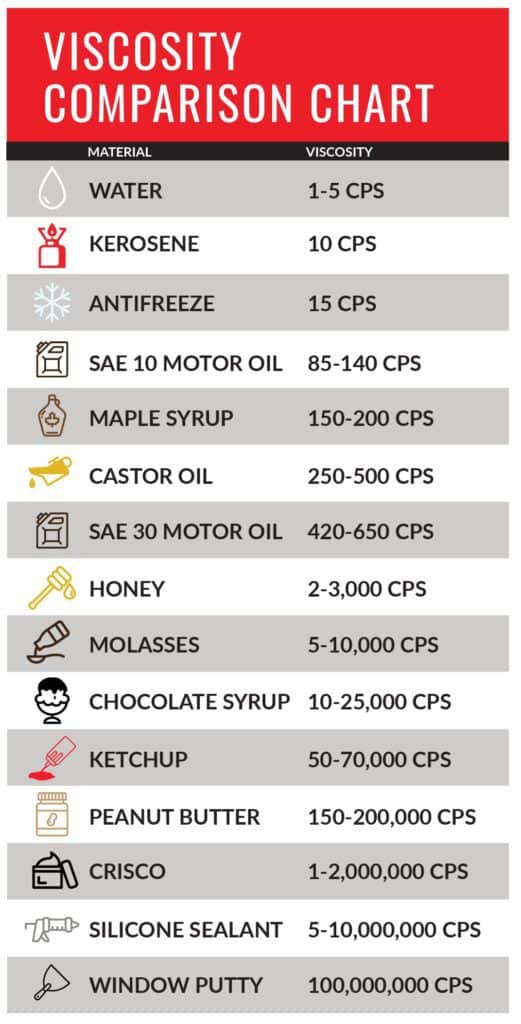How To Find Viscosity Of Water
Viscosity is the measure of a material'southward resistance to motility nether an applied force. There are several formulas and equations to calculate viscosity, the nigh common of which is Viscosity = (2 ten (ball density – liquid density) x chiliad x a^ii) ÷ (9 x v), where chiliad = dispatch due to gravity = 9.8 thou/s^2, a = radius of ball begetting, and 5 = velocity of ball bearing through liquid.
If you want determine viscosity in a liquid, try a simple science experiment by measuring the speed of a metal ball dropped in a container of liquid. The velocity of the brawl, combined with the relative densities of the ball and the liquid, can be used to calculate the viscosity of liquids. Only you can't calculate viscosity unless you know what it is and why it's of import.
Definition of Viscosity
The definition of viscosity is "the quantity that describes a fluid's resistance to flow. Fluids resist the relative movement of immersed objects through them as well as to the movement of layers with differing velocities within them." Knowing how thick your cloth is can accept huge impact on your ability to get work done. Material such equally honey or glue tend to be thicker and are described as having a higher viscosity, whereas water and glycol are less viscid and menstruum faster.
Temperature as well plays a critical role in the viscousness of a liquid. By and large speaking, the warmer a liquid is, the lower its viscosity is and the easier it flows. The colder information technology is, the more than sludge-like information technology becomes and has a college viscosity. Understanding how to summate viscosity can be helpful when deciding if your fabric is ready to apply or not. So how do you determine the viscosity?

Endeavour This Out
Calculating the Density of the Ball
- Measure the mass of your ball, using your rest. For example, suppose the mass of the brawl is 0.1 kilograms (kg).
- Find the radius of the ball by first measuring the bore (distance of a straight line through the ball at the widest part). Split the diameter by 2; this gives the radius of your ball.
- Calculate the volume of the ball by plugging the radius into the equation for the volume of a sphere. Suppose the ball begetting has a radius of 0.01 meter (k). The volume would be: Book = 4/3 10 pi ten (0.01 thousand) ^3 = 0.00000419 one thousand^iii
- Calculate the density of the ball by dividing its mass past its volume. The density of the brawl in the case would be: Density = 0.1 kg ÷ 0.00000419 m^three = 23,866 kg/yard^3
Calculating the Density of the Liquid
- Mensurate the mass of your graduated cylinder when it is empty. And then measure the mass of your graduated cylinder with 100 millilters (mL) of liquid in it. Suppose the empty cylinder had a mass of 0.2 kg, and with fluid its mass was 0.45 kg.
- Determine the mass of the fluid by subtracting the mass of the empty cylinder from the mass of the cylinder with the fluid. In the example: Mass of liquid = 0.45 kg – 0.two kg = 0.25 kg
- Determine the density of the fluid by dividing its mass by its volume. Example: Density of fluid = 0.25 kg ÷ 100 mL = 0.0025 kg/mL = 0.0025 kg/cm^three = 2,500 kg/m^three*
- 1 mL is equal to ane cm^3 *ane one thousand thousand cubic centimeters equal 1 cubic meter
 Calculate Viscosity of Liquid
Calculate Viscosity of Liquid
- Fill your tall graduated cylinder with the liquid to be tested and so it is about 2 cm from the top of the cylinder. Use your marking to brand a mark two cm below the surface of the liquid. Mark another line 2 cm from the lesser of the cylinder.
- Measure the altitude between the two marks on the graduated cylinder. Suppose that the altitude is 0.3 m.
- Let the brawl go along the surface of the liquid and use your stopwatch to time how long it takes for the ball to fall from the first mark to the 2d mark. Suppose it took the brawl vi seconds to autumn the distance.
- Calculate the velocity of the falling ball by dividing the altitude it fell by the time it took. In the example: Velocity = 0.3 m ÷ six s = 0.05 m/s
Summate viscosity of liquid from the data you have collected:
- Viscosity = (2 x (ball density – liquid density) x g x a^two) ÷ (9 ten v), where grand = acceleration due to gravity = 9.8 m/s^2, a = radius of ball begetting, and five = velocity of brawl bearing through liquid.
- Plug your measurements into the equation to calculate the viscosity of the liquid. For the instance, the adding would wait like this: Viscosity = (2 x (23,866 – 2,500) x ix.8 x 0.01^ii) ÷ (nine x 0.05) = 93.one pascal seconds.
Viscosity Calculation Formula:
viscosity = shear stress / shear rate
The result is typically expressed in centipoise (cP), which is the equivalent of 1 mPa due south (millipascal 2nd).
Powerblanket Solutions
Powerblanket makes it easy to lower the viscosity of many industrial fluids by heating the container evenly to the desired temperature, assuasive your cloth to attain the preferred viscousness for use. This saves you time and coin, getting back to work instead of waiting for external temperatures to naturally warm up your material.
Powerblanket offers diverse fix-to-ship viscosity products, from bucket and drum heaters to IBC tote heaters. We can also produce custom solutions for most applications. If you need better flowing fluids, Powerblanket has y'all covered.
Source: https://www.powerblanket.com/blog/let-it-flow/
Posted by: prevostnotheires.blogspot.com


0 Response to "How To Find Viscosity Of Water"
Post a Comment